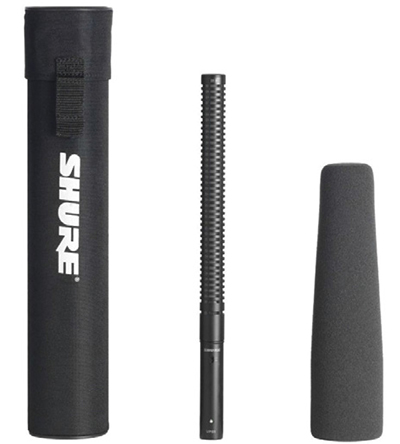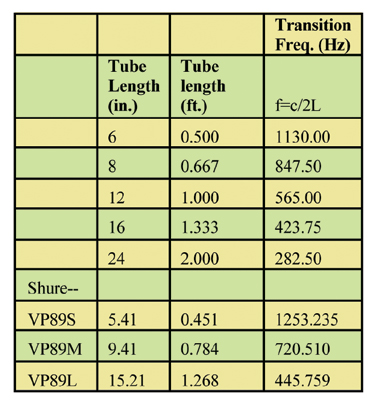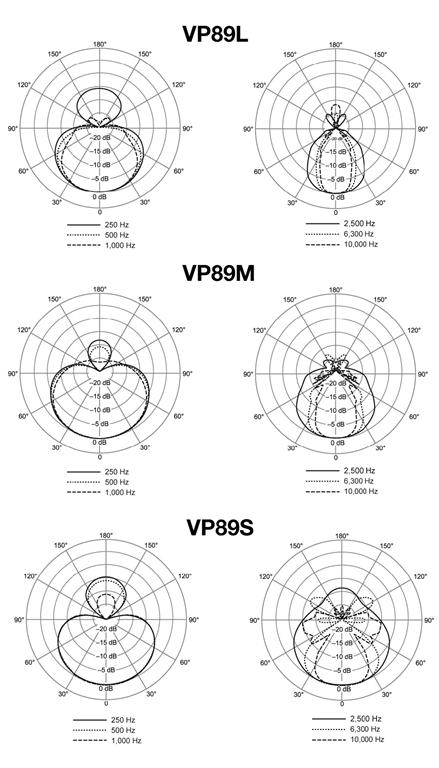Shotgun Microphones— In Theory and in Practice

Mary Gruszka
Highly directional microphones, those with a very narrow pickup pattern, are essential when trying to capture distant sound or pick out particular sources in a noisy environment. That’s why you’ll see long, tubeshaped mics mounted on cameras for news or sports gathering or hanging from booms on sound stages.
The tube shape is an integral element in creating the directional characteristics of the mic. A clue to its function can be ascertained through another name for this type of microphone—interference tube.
The tube is mounted in front of and over the microphone capsule and is built with an opening in the front and a series of side openings or slots. The openings are covered with acoustic material and sometimes a grill, which allows sound to pass through. The tube and slot structure is designed so that sound waves are directed down the tube towards the capsule rather than exiting the opposite end.
Sound waves “hitting” the mic on-axis (in the direction the mic is pointing) take the shortest path down the tube to the capsule. But sound pressure waves arriving off-axis from the sides of the mic enter through the various side openings. Once inside the tube, they take more time to arrive at the capsule than the direct sound since they have to travel slightly greater distances.

Shure VP89 Shotgun mics Another way of describing these delays is that off-axis sound waves experience phase shifts, which are dependent on frequency, angle of incidence and the design of the tube. The result is that at the capsule, the vector sum of the on- and off-axis sound pressure favors the on-axis, while the offaxis sound gets more or less cancelled.
But the degree of cancellation isn’t total at certain frequencies and angles of incidence. If one were to go through the vector arithmetic (here’s where phasor math comes in handy for summing signals with different amplitudes and phase angles), it would show that there are dips and peaks in the polar response and that the cancellation isn’t total at some frequencies and angles of incidence. There often are some side and rear lobes in polar response. Also, higher frequencies tend to have a narrower pickup pattern than lower frequencies.
Yet the on-axis response could be 20 dB or more than at the side or rear, with that higher ratio allowing more mic preamp gain to amplify the distant sounds, giving the shotgun mic more apparent “range” in direct sound pickup.
Low-frequency pattern control is one factor to consider when choosing a shotgun mic. At some lower frequency, the tube no longer causes interference due to the longer sound wavelengths. Longer tubes provide more directionality at lower frequencies than shorter ones.
The transition frequency where the tube no longer has an effect is calculated by dividing the speed of sound by twice the length of the tube. Below this frequency, the tube is effectively out of the picture as far as directivity response is concerned. Directivity now depends on the inherent polar response of the microphone.

Table 1: Calculations for transition frequency for some hypothetical tube lengths, and for the Shure VP89 shotgun mic with the short (S), medium (M), and long (L) tubes. Table 1 illustrates this with some sample calculations of the transition frequency for some hypothetical shotgun tube lengths, and also for a real product, the Shure VP89 shotgun mic. This Shure mic makes tube length comparisons easy since a common microphone capsule section can be outfitted with one of three interchangeable tubes, depending on the application.
The specifications indicate that the long tube has an acceptance angle of 30 degrees with applications for long-distance sound pickup such as for ENG, sports and field recordings. (The spec sheet does not indicate which frequency or frequency band for the acceptance angle.)
The medium length tube is listed with a 50-degree acceptance angle and is useful for “a greater degree of ambience” for audience response and live events, for example. Finally the short tube has an acceptance angle of 70 degrees and applications for near-field sound pickup as on a camera mount.
Above the transition frequency the interference effects start to kick in, and increases with more frequency. At about two or three times this transition frequency, the highly directional characteristics really become apparent, in actual performance and as seen on the polar patterns graphs in Fig 1.
In operation, the shotgun mic should be used out in the open, and its slots shouldn’t be blocked. Keep the mic away from unwanted loud sounds to the side and rear. A loud sound closer to the side or rear of the mic can end up at about the same level as a more distant on-axis sound, as “seen” from the capsule. These will be quite audible.
Study the polar patterns to help aim the mic for optimum pickup and the greatest rejection of unwanted sound, which may be from the side rather than the rear.
Fig. 1: Polar responses of the Shure VP89 for the three different tube sizes (Click to Enlarge)
Don’t try to be stealthy by placing only part of the mic outside a window or door, with the rest inside. That effectively blocks the side slots and defeats the whole purpose of having a shotgun mic in the first place.

Even with good design and construction, a shotgun mic will have bumps in frequency and phase response and the polar patterns due to the interference effects, with the differences in the side pickup especially prominent. Match the response to the application, like voice (speech or song), music, ambient sound, wildlife, etc.
Being so highly directional, shotgun mics are sensitive to wind noise, not only from nature, but from manmade sources. Use a good windscreen, and if needed, add on a furry cover. Just make sure the furry cover doesn’t become wet or matted down.
Many shotgun mics provide a switchable low-frequency filter to help reduce wind noise. There’s a trade-off, of course, with decreased low-frequency response, but it may be the only choice in certain situations.
So experiment. Shotgun mics are a useful addition to anyone’s microphone collection.
Mary C. Gruszka is a systems design engineer, project manager, consultant and writer based in the New York metro area. She can be reached via TV Technology.
Get the TV Tech Newsletter
The professional video industry's #1 source for news, trends and product and tech information. Sign up below.
